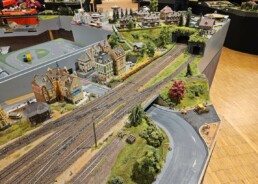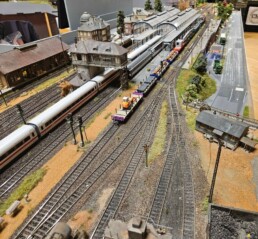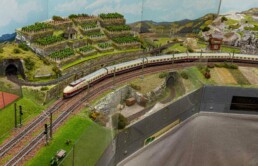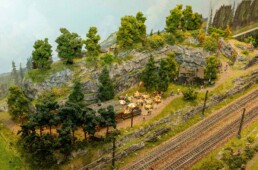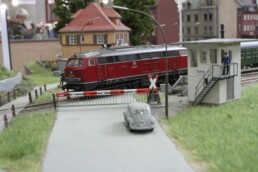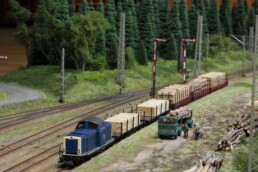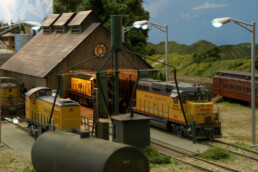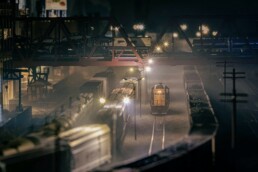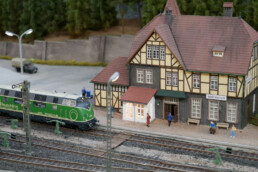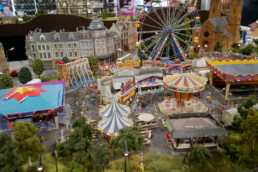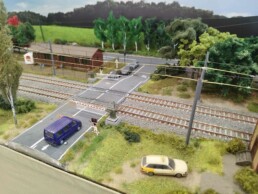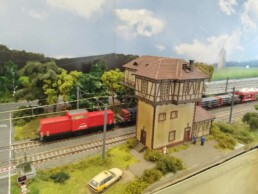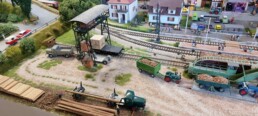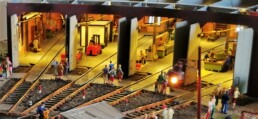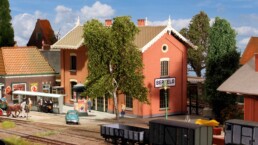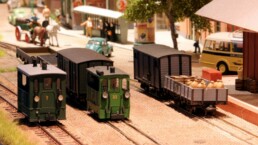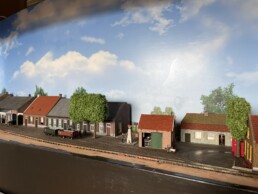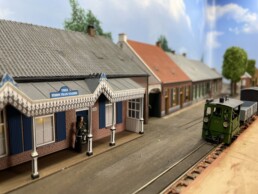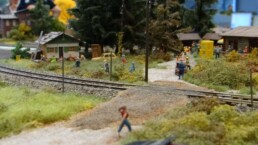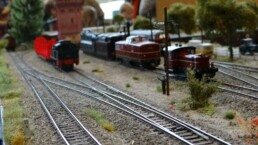The H0 scale model railroad plants introduce themselves
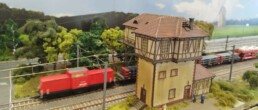
H0 gauge: Fantasy model railroad layout
The model railroad layout of the MEC Pfullendorf is a double-track main line in pure fantasy design.
The 6-track station is richly decorated with an old town backdrop and has a length of 8 meters. It has an external subway station, where a festival with carnival and beer tent is taking place on the outskirts of the city. There are also vehicles with the Car System on the street.
The layout of the line is rural and winding on both sides of the station.
A reversible module shows an ancient old town with a modern open-air cinema located in front of the town wall. Here, homemade films are shown live on a screen via a projector.
The second turning module has a 4-track staging yard. In addition to a dam wall with E Werk, everything is landscaped with a spacious petting zoo. There is also a sawmill, a restaurant with an illuminated wine cellar and a nursery.
Operator: Model Railway Club Pfullendorf, 88639 Pfullendorf
System size: 10 x 6 m
H0 gauge: Modular layout of the Endersbach model railroad group
The modular layout of the Endersbach e.V. model railroad group has no real-life model.
The individual modules show self-contained themes, which can be combined almost at will and still convey a harmonious picture to the viewer. The entire layout is designed as a double-track main line and leads past lovingly designed landscapes.
The two three-track through stations are the operational centers. These allow for interesting and varied operations, including reversible trains.
The aim of the model railroad group is to present the viewer with a wide variety of train sets from different eras.
The modular system is fully digitalized and is controlled centrally and automatically using the Rocrail® software.
Operator: Endersbach model railroad group, 73249 Wernau
System size: 13 x 6 m
H0 gauge: Modular layout single-track main line
The system consists of 66 modules and has a total length of around 90 meters.
A single-track main line with 6 different operating stations is shown. The vehicles used correspond to Era 3. The traction units at the two terminal stations are prototypical. In between is the multi-track crossing station “Kirchzarten”, which reproduces the prototype station as it was in the mid-70s of the last century.
The stations allow a variety of shunting movements. In addition to the prototypical train sets, freight traffic is also demonstrated in the form of local freight trains with delivery to loading points and sidings in the stations and transfer trains that deliver freight cars to neighboring stations or loading points or pick them up there.
Operator: Eisenbahnfreunde Breisgau, 79100 Freiburg
System size: 20.5 x 14 m
H0 gauge: BEANS US-Modelrailroad
The elongated HO layout with center backdrop from Beans, H0 is set in Iowa. The all-round layout can be driven on both sides over the full length of 17.50 m and offers two independent themed areas separated by the center backdrop.
One side is characterized by the small Lotzburgh country station with a few loading sidings, a small depot, a farm and agricultural businesses with sidings.
On the second side is the town of Dakota City with a marshalling yard, many businesses, a container yard and a large diesel store.
The attraction of the layout lies in the combination of the long trains running on the main line and the busy shunting traffic due to the many sidings.
Operation is digital with radio hand controllers. This means that the “engine driver” accompanies his train around the layout and has a fascinating view of a wide variety of scenery. US trains of all eras can be driven.
Operator: IGM BEANS US-Modelrailroad, 42109 Wuppertal
System size: 18 x 3 m
H0m gauge: Railways through the German low mountain range
The single and double-track model railroad layout of Era III and IV has no fixed model. It is based on models that can be found in the German low mountain ranges (Eifel, Bergisches Land). Stations are located on the single-track sections for the purpose of train crossings.
To the right and left of the tracks you will find a brewery, timber operations/sawmills, reservoir with power generation, fair, weekly market, restaurants, farms and a replica of the Moselle bridge of Bullay.
To involve visitors, the model railroad layout has various push buttons that can be used to set figures or the like in motion on the layout.
The modular system is operated digitally. If visitors (especially children) are interested in operating a station or running a train themselves during the exhibition, this is possible under supervision.
Operator: Rhein-Sieg Railway Club, 53721 Siegburg
System size: 20 x 6 m
Gauge H0: Modular layout Wajcha Poznan
The modular system from Wajach Poznan in Poland consists of seven segments.
At both ends there is a hill into which the trains can enter and the cars with the Car System also have their loops. The trains run in a closed circuit on a double-track line! There are six tracks behind the scenery so that trains from eras I to VI can be shown.
The model railroad layout has interactive buttons with which visitors can set the Viessmann figures in motion. The landscape design of the model railroad layout with a beautiful viaduct bridge is very detailed!
Operator: Wajcha Poznan, Poland – 62-030 Swarzedz
System size: 11 x 1 m
HO scale: Single-track fictitious branch line with terminal station and depot
The modules and segments layout is in epoch end 3 beginning 4. The railroad is part of the whole but not the dominant theme.
The background was painted by Mr. Christoph Laubmann with oil paints according to the builder’s instructions. The two-wire layout is controlled with a Märklin CS3 in semi-automatic operation, so that there is still an operation for a dispatcher.
A railroad festival with an “open day” is taking place in the railroad depot with its 4 permanent engine shed. Young visitors can visit the interior, which has been recreated down to the last detail.
A mobile crane is used to lift the cover of the oil separator between the turntable and the locomotive line and place it to one side. When the work is done, the cover is put back in place. Two rails run from the turntable to the station. Steam locomotives can be turned here and re-coupled to their wagons.
There is a loading track with a gantry crane at the small rural station. It can be used to load goods from road to rail. The loading works with small motors and magnets via a control panel, just like in reality.
There is also a beet loading area as was common at the time. Next to the station is a restaurant with a beer garden where 5 couples dance in a circle to music. Powered by a motor and cogwheels under the module.
On the next module there is a campsite with a bathing lake and restaurant. Through the windows you can see the interior of the restaurant with bar and the kitchen. On the hill is a cemetery with a small church where the bells ring regularly. Opposite in the forest, a UFO with the drive lands under the module.
The ride continues to the next module, where the Kurhotel Schönblick with spa gardens is located, behind which there is a small stopping point. The ride continues over a small bridge with a stream that flows into a lake, on which an excursion boat is getting ready to dock, past a field with a potato harvest.
Now we reach the medieval market with a jousting tournament and its 16 stalls. There is a procession moving towards the Ferris wheel, children’s carousel and flying carpet. The train disappears into a tunnel to the staging yard, above which Felsenstein Castle towers.
The staging yard is covered with vines and a farm. The small Y-shaped castle towers above the vines. The Y-castle in Stetten i.R. has been faithfully recreated.
Operator and builder: Bernd Schmitz and Ursula Schmidt
System size: 8 x 1.25 m
Track H0 / H0m: Berkelo
Berkelo is an imaginary small Dutch town in the late 1950s, situated on the river Berkel with poor rail and road connections to the hinterland. The railroad bridge over the river was blown up during the Second World War and has still not been repaired. Therefore, the streetcar is still in operation, which has a connection to the hinterland, albeit via a detour.
The industry on the railroad uses the railroad for its intensive freight transport. The small port also uses the railroad to transport its goods!
This route is pure fantasy, but it really could have been like this. In the 1930s, such rail and streetcar lines were still common in Holland. But shortly afterwards, partly before, but especially after the war, the streetcar lines disappeared.
Operator: Paul Roodbol, NL – 7242 KE Lochem
System size: 3.5 x 0.6 m
H0e gauge: Tramway on the Sint Janstraat in Uden (first performance)
The railroad hobby club “De Tenderloc” from Uden (NL) has brought along its new streetcar line: a “spectacle” in the Sint Janstraat in Uden around 1910. All the buildings were recreated using old photos.
“De Tenderloc” is known for its self-developed moving figures, which can also be found on the streetcar layout, such as: the waitress and the innkeeper, cat on the windowsill, dance with shutters, the cattle car, pair of horses with fire engine, etc.
The association is also working hard to build the “Veghel” steam streetcar itself with matching carriages that stopped in front of the station in Uden.
Operator: De Tenderloc, NL – 5401 AZ Uden
System size: 1.8 x 0.6 m
Gauge H0 2L: Huchlerhausen branch station with through traffic
The layout effectively shows the necessary and extensive shunting traffic at a secondary station and the hustle and bustle. However, there is no shortage of passenger and freight traffic, as the station is constantly passed by passenger and freight trains. Steam and diesel locomotives are waiting for their turn.
The special features can be seen in uncoupling and assembling certain individual freight cars! The layout is not quite finished yet. But there are already many great scenes to see. In terms of time, we are in eras 3-4-(5) with digital control.
Steam and diesel locomotives will be on display – as well as the freight wagons of a busy operation in the branch station.
The special attraction is the combination of maneuvering and driving and detailed representations.
Operator: Modellbahnfreunde Leutkirch, 88410 Wurzach
Plant size: 6 x 3 m
